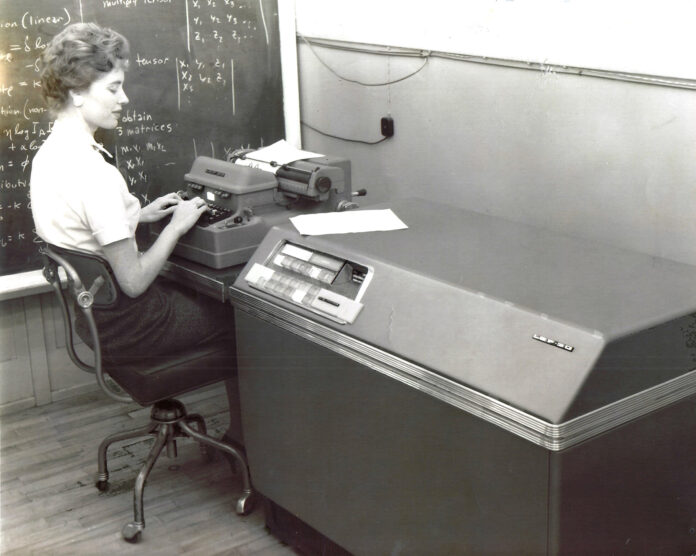When walking into the Black Diamond History Museum, you might be greeted by the smiling face of Lynn Mason, a docent who is 89 years young. Lynn and Don Mason, her husband of 68 years, are charter members of the museum dedicated to preserving history in the local area.
Back in 1958 when this photo was taken, Lynn Mason was a secretary working for Douglas Aircraft Company in Santa Monica, California. She was part of the Materials Research and Process Engineering Group working in their facilities at the Santa Monica Airport. Here she’s typing commands into an LGP-30, an early off-the-shelf desk computer. LGP or Librascope General Purpose, contained 113 electronic tubes plus 1450 diodes and required 1500 watts of power. When introduced in 1956, it retailed for $47,000, the equivalent of $538,000 today.
Mary Lynn Bird was born at Seattle’s St. Luke’s Hospital in 1935 and grew up near Burien, graduating from Highline High School in 1953. The day after graduation, her family moved to Middletown, Ohio when her father was transferred there by Boeing. At a Miami of Ohio University orientation, she met Don Mason. The following year, he moved back to the Seattle area with the Bird family. Don was soon drafted into the Army and upon discharge in 1956, the couple married. After a short honeymoon, the newlyweds set forth on an adventure to build a new life in sunny California. They rented an apartment next to the Santa Monica Airport and both found jobs with Douglas Aircraft whose line of DC planes dominated commercial aviation in the 1950s.
Don Mason was laid off in 1958, so Lynn supported him as he pursued a degree at Santa Monica Junior College. Having lived in Santa Monica for two years, Don was eligible for the resident’s tuition rate of $2.50 per semester earning his two-year certificate for $10. Two years later, he graduated from Cal State, Los Angeles with a degree in history. Around 1964, when Lynn was pregnant with their first son, the Masons moved to Kent, Washington where Don joined Boeing in a finance job. He worked there for 31 years before retiring.
One Sunday afternoon in the early 1970s, Don and his two sons, Scott and Mark hiked through the woods around their Panther Lake home. They happened upon the Saar Pioneer Cemetery established by Peter Saar when he buried his wife there in 1873. They saw a large headstone marking the final resting place of Johnnie Hall, a 21-year-old, whose inscription read, “Killed in Franklin Mines, Aug. 24, 1894.” Hall was one of 37 coal miners who suffocated from a fire marking Washington’s second-worst coal mine disaster. Don was intrigued by Hall’s grave-mark and a few weeks later with Lynn and the two boys in tow, the family traveled to Black Diamond. At City Hall, they ran into Ted Barner, a retired coal miner who offered to take them to Franklin.
The Masons quickly caught the history bug. Don and Lynn were soon enlisted by Carl Steiert who assembled a group of volunteers to form the Black Diamond Historical Society in 1976, the year of the nation’s bicentennial. Over the past five decades, the Masons have tirelessly served the museum from leading Franklin tours to docent work on Thursdays and weekends. If you’ve never visited this small-town museum, you’re in for two treats – first, it’s one of the best in the state, and second, you may be greeted by Lynn Mason’s beautiful smile.







